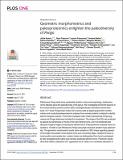Por favor, use este identificador para citar o enlazar a este item:
http://hdl.handle.net/10261/348154COMPARTIR / EXPORTAR:
 SHARE SHARE
 CORE
BASE CORE
BASE
|
|
| Visualizar otros formatos: MARC | Dublin Core | RDF | ORE | MODS | METS | DIDL | DATACITE | |

| Título: | Geometric morphometrics and paleoproteomics enlighten the paleodiversity of Pongo |
Autor: | Kubat, Jülide; Paterson Ryan; Patramanis, Ioannis; Barker, Graeme; Demeter, Fabrice; Filoux, Arnaud; Kullmer, Ottmar; Mackie, Meaghan; Marqués-Bonet, Tomàs CSIC ORCID ; Huong, Nguyen Thi Mai; Tuan, Nguyen Anh; Pheng, Sytha; Rippengal, Jessica; Schrenk, Friedemann; Souksavatdy, Viengkeo; Tshen, Lim Tze; Wattanapituksakul, Athiwat; Wang, Wei; Zanolli, Clément; Cappellini, Enrico; Bacon, Anne-Marie | Fecha de publicación: | 15-dic-2023 | Editor: | Public Library of Science | Citación: | PLoS ONE 18(12): e0291308 (2023) | Resumen: | Pleistocene Pongo teeth show substantial variation in size and morphology, fueling taxonomic debates about the paleodiversity of the genus. We investigated prominent features of the enamel-dentine-junction junction (EDJ)–phylogenetically informative internal structures–of 71 fossil Pongo lower molars from various sites by applying geometric morphometrics and conducted paleoproteomic analyses from enamel proteins to attempt to identify extinct orangutan species. Forty-three orangutan lower molars representing Pongo pygmaeus and Pongo abelii were included for comparison. The shape of the EDJ was analyzed by placing five landmarks on the tip of the main dentine horns, and 142 semilandmarks along the marginal ridges connecting the dentine horns. Paleoproteomic analyses were conducted on 15 teeth of Late Pleistocene Pongo using high-resolution tandem mass spectrometry. The geometric morphometric results show variations in EDJ shape regarding aspects of the height and position of the dentine horns and connecting ridges. Despite the issue of molar position and sample size, modern molars are distinguished from fossil counterparts by their elongated tooth outline and narrowly positioned dentine horns. Proteomic results show that neither a distinction of P. pygmaeus and P. abelii, nor a consistent allocation of fossil specimens to extant species is feasible. Based on the EDJ shape, the (late) Middle to Late Pleistocene Pongo samples from Vietnam share the same morphospace, supporting the previous allocation to P. devosi, although substantial overlap with Chinese fossils could also indicate close affinities with P. weidenreichi. The hypothesis that both species represent one chronospecies cannot be ruled out. Two fossil specimens, one from Tam Hay Marklot (Laos, Late Pleistocene), and another from Sangiran (Java, Early to Middle Pleistocene), along with some specimens within the Punung sample (Java), exhibit affinities with Pongo abelii. The Punung fossils might represent a mix of early Late Pleistocene and later specimens (terminal Pleistocene to Holocene) related to modern Pongo. The taxonomy and phylogeny of the complete Punung sample needs to be further investigated. | Versión del editor: | https://doi.org/10.1371/journal.pone.0291308 | URI: | http://hdl.handle.net/10261/348154 | DOI: | 10.1371/journal.pone.0291308 | E-ISSN: | 1932-6203 |
| Aparece en las colecciones: | (IBE) Artículos |
Ficheros en este ítem:
| Fichero | Descripción | Tamaño | Formato | |
|---|---|---|---|---|
| Geometric_PLoS-ONE_2023_OA.pdf | 2,36 MB | Adobe PDF |  Visualizar/Abrir |
CORE Recommender
Page view(s)
27
checked on 07-may-2024
Download(s)
12
checked on 07-may-2024
Google ScholarTM
Check
Altmetric
Altmetric
Este item está licenciado bajo una Licencia Creative Commons

